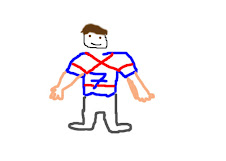Arts and Crafts Summary
Berbers have many arts that they have kept alive for years.
The first art I will be talking about is Tailoring (special clothes). Berbers have to wear elegant dressing during festivities. Men are expected to wear fine woolen jellabas, quality leather babouches and a rezza. The rezza is a long piece of cloth that goes around the head several times, like a turban. If they like, they can choose to wear a selham : a long wool cape that goes over the jellaba and that has a hood. On their knuckles, men wear isifn : a soft piece of wool that is wrapped around the knuckles and painted with henna. On the other hand, women wear completely different clothes. They wear a long white robe (not kaftan). On top of that goes a jellaba covered with mouzoun. Mouzoun is small circular pieces of metal that are made to shine, and embellish things. They also wear babouches, but much different than those of men. They are coloured and have fancy embroidery on them. Women also wear isifn, and a scarf, covered with mouzoun.
Jewelry is part of everyday life in berber societies and it is also considered, an art. Generally, women are the ones who wear jewelry. Men might wear a silver ring but nothing more. Women wear jewelry all over their body. On their neck, they have necklaces either made of silver, or they can have bulky, colourful pendants. They wear large silver bracelts with colourful rocks (semi-precious or non precious) They also wear similiar « bracelts » on their ankles.
Another art I will be talking about is the making of carpets. Berbers make all of their carpets out of natural sheep wool. First, they have to wash it. Then, they run rhe wool through two square boards with metal teeth on them to refine the wool. After that, they start tying it into strings to prepare it to go on the loom. Then, they can put designs, and natural vegetable dyes to make it prettier. Some carpets can take from a few weeks to several months to accomplish.
Pottery is another art that is popular among men and women in Berber societies. Although pottery is generally used for cooking, it also can carry out decorative purposes. Tajines are used for cooking but some are decorated, painted, and made to be exposed as decoration. Some « tajines », are about the size of a hand, and are used to carry salt and pepper. Large dishes with tiling also fall into the category of pottery. They have clourful tiles and designs. They can be used to carry fruits, or can be hung up on the wall. The mkhabia is the « refrigerator of the atlas ». It stores large amounts of water and can be painted or engraved so that guests appreciate the house.
Finally, I would like to talk about a few things that fall into none of these categories : The dagger, the leather bag, and the hides. Daggers are only worn by rich and respected men as a sign of wealth and authority. They are decorated with ornaments, beads, and silk thread. It hangs by the side of the body, usually to the right
The second thing is the leather bag. It serves many purposes : carrying papers, knives Tools, but most importantly : decorating. It too hangs on the side of the person and is made of goat leather. It can have embroidery, shells, pendants, and colouful ornaments too.
Finally, there are animal hides. These are made from goat or sheep leather with the hair or wool kept on them. These are usually made after the slaughter of a sheep, or other animal. They can be used to sleep on, as a praying matress, or as a decorative carpet.
Why should we keep Berber Arts ? I believe that we should preserve Berber arts and crafts because if we were to take them away, we would slowly be killing a civilization that has fought hard to keep it’s traditions and culture in a modern world.
